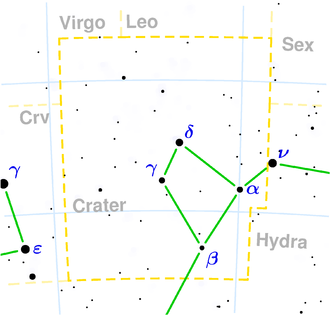NGC 3956
| Galaxy NGC 3956 |
|
|---|---|

|
|
| AladinLite | |
| Constellation | cups |
|
Position equinox : J2000.0 , epoch : J2000.0 |
|
| Right ascension | 11 h 54 m 00.7 s |
| declination | -20 ° 34 ′ 02 ″ |
| Appearance | |
| Morphological type | SA (s) c / HII |
| Brightness (visual) | 12.2 mag |
| Brightness (B-band) | 12.9 mag |
| Angular expansion | 3.30 × 1.0 |
| Position angle | 58 ° |
| Surface brightness | 13.3 mag / arcmin² |
| Physical data | |
| Affiliation | NGC 4038 group |
| Redshift | 0.005487 +/- 0.000017 |
| Radial velocity | 1645 +/- 5 km / s |
|
Stroke distance v rad / H 0 |
(66 ± 5) · 10 6 ly (20.3 ± 1.4) Mpc |
| history | |
| discovery | William Herschel |
| Discovery date | March 10, 1785 |
| Catalog names | |
| NGC 3956 • PGC 37325 • ESO 572-013 • MCG -03-30-016 • IRAS 11514-2017 • 2MASX J11540068-2034023 • SGC 115128-2017.3 • GC 2610 • H III 290 • h 3368 • LDCE 856 NED002 | |
NGC 3956 is a bar-spiral galaxy with extensive star formation areas of the Hubble type SBc in the constellation Crater south of the celestial equator . It is an estimated 66 million light years away from the Milky Way , about 70,000 ly in diameter, and is part of the NGC 4038 group .
In the same area of the sky are u. a. the galaxies NGC 3957 and NGC 3981 .
The object was discovered on March 10, 1785 by the German-British astronomer Wilhelm Herschel .
